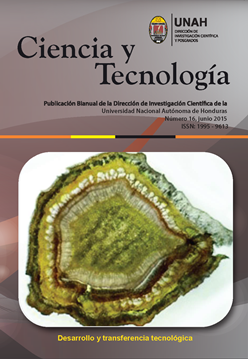Risk factors for venous thromboembolism in the Honduran population
DOI:
https://doi.org/10.5377/rct.v0i16.2177Keywords:
venous thromboembolism, risk factors, thrombophilia, factor V Leiden mutation, prothrombin G20210A mutation, protein S, protein C, antithrombin, fibrinogen.Abstract
Factor V Leiden and Prothrombin G20210A (FII) mutations, Antithrombin, Protein C and S deficiencies, and high levels of Fibrinogen are related genetic risk factors for venous thromboembolism which exhibits high incidence and morbidity worldwide. The objective of this study was to determine the prevalence of these risk factors in healthy individuals of Honduras. 93 samples were collected from both gender participants between 17 to 70 years old, with no previous history of venous embolism, acute or chronic diseases such as diabetes, systemic lupus erythematosus, cancer, mieloproliferative disorders, liver and renal diseases. The study was approved by the Ethical Review Board of the Social Security National Institute and the information was obtained through an Informed Consent Form. Clot based and turbidimetric methods were used to measure the control proteins (Stago, Human) and real time polymerase chain reaction (RT-PCR, LightCycler 2.0, Roche) was carried out to screen Factor V Leiden and Prothrombin G20210A. The frequencies of Antithrombin, Protein C y S decreased levels were 6.4, 10.7 and 11.8%, respectively. In general, our data was higher than the reported in the general population, with levels less than 2%. Fibrinogen levels were found increased in 5.4% of the sample. In regard the allelic polymorphism, Prothrombin G20210A frequency was 2.15% with heterozygous form, similar to the reported worldwide; no Factor V Leiden mutation was detected even if its average prevalence in the Western population is 10-15% and in Latin-Americans is 1.6-5.1%. No more than one disorder was observed in the subjects of the study. Our data is not generalizable due to the size of the sample but it reveals hemostasis unbalance in healthy subjects.Thrombophilic screening in the hemostasis laboratory may be valuable in selected patients exposed to risky procedures or medications, to prevent venous embolism with anticoagulation therapy. It would be important to develop these studies in the country to contribute for the venous embolism prevention and management. Prothrombin G20210A mutation is first time reported in the Honduran population.
Revista Ciencia y Tecnologia No. 16, Junio 2015: 25-35
Downloads
966
Downloads
Published
How to Cite
Issue
Section
License
© Revista Ciencia y Tecnología
Authors who publish in this journal accept the following conditions: In accordance with the legislation of copyright, Revista Ciencia y Tecnología, recognizes and respects the moral right of authors, as well as the ownership of the patrimonial right, which will be ceded to the magazine for its diffusion in open access in printed version and in digital format. By being part of multiple indexers, databases and reference systems, the articles published by Revista Ciencia y Tecnología will be visible and will be downloaded from these websites, indicating, in all cases, the authorship of the articles, the date of publication and the number of the journal to which they correspond.




